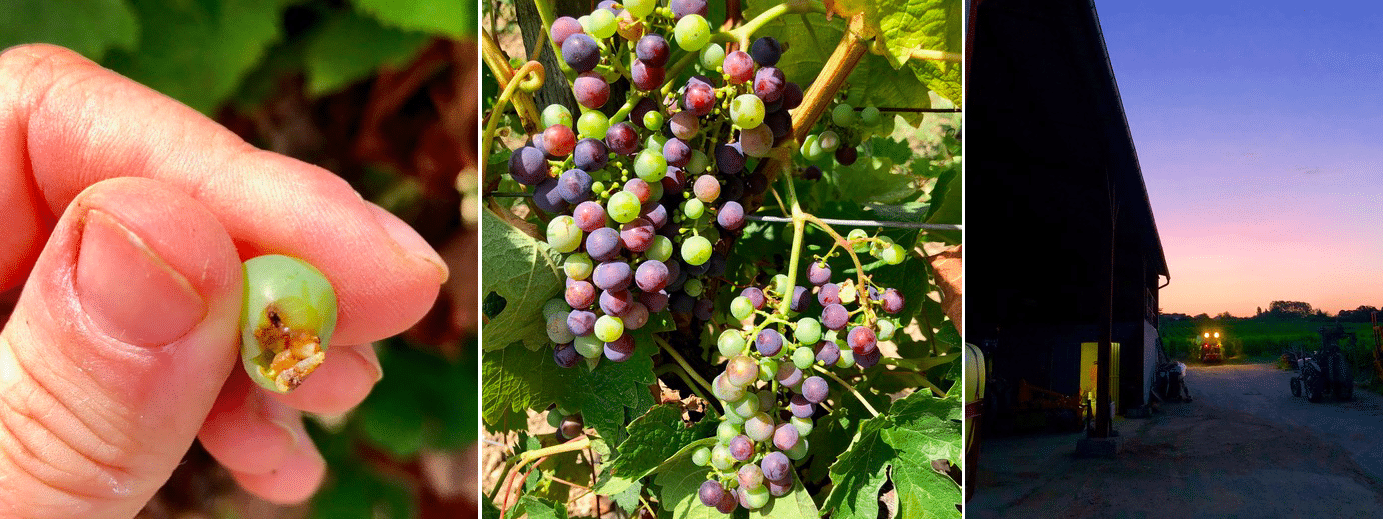Chloë, reporting from Rions – part 2
Our very own Chloë Schwartz left on June 25 for a 6 month internship at Château Haut-Rian, in Entre-Deux-Mers. Read our July 19 post for the beginning of her adventure!
“Bonjour Équipe V.O.S. !
Monday of last week (the 5th), I spent the day counting vers de la grappe (worms) in parcels of red grapes. I had visited many of these parcels just two days before, but over the weekend, véraison had occurred. After spending a month staring at lime green bunches, it felt magical to see a creep of purple arrive so quickly.
Véraison marks the midpoint of ripening. In the past, vignerons would mark the arrival of véraison and start harvest 40-45 days later. According to Pauline, despite all of the scientific advancements to determine optimal ripeness for harvest, this timeline remains accurate. What about white grapes? The trick is to feel the bunch with your fingers. If the flesh gives a little when pressed, véraison is in progress.
If you’re wondering about the worms – some parcels were more afflicted than others. Worm counting is harder than it sounds; you might find a hole in a grape but not a worm, or you gently pry open a perfect looking bunch and find an infestation. It requires a lot of concentration. The real blight of the summer, however, is sun damage. Not only are there sunburns on bunches and leaves, but many vines have grapes that are simply tiny due to the lack of water. Two canicules (heat waves) with no rain in between has made for a tough season. The rain that has come since has been so heavy that it doesn’t permeate the ground and can cause more harm to the vines than good.

Vers de la grappe (worms) / véraison in progress / mandated 6am start during the canicule.
As we make our rounds through the parcels (the parcels are stretched across 5 villages: Rions, Béguey, Laroque, Capian, Cardan, & Soulignac), it is impossible not to notice the vast amount of public works projects happening in the area. There are crates of granite stacked along the roads. In fact, France is currently in the middle of a granite shortage because of municipal elections scheduled for later this year! All over France, incumbents are racing to put granite on their roadsides and complete a litany of public works projects before the elections. Last week, 3 new stop signs were installed along the route I take to work (a 7 minute walk).
During the recent canicule, we were legally mandated to start work at 6 a.m. One morning, I was tasked with replacing the sulphur in the serpentines on top of the cuves. The (diluted) sulphur acts as a protective barrier for the wine while also enabling the wine to expand/contract in the tank. Just when I thought I was done, I was taken to a room full of tanks known as the Discotheque (in its former life, the building was a Discotheque; Pascal used to party there). Unlike the main room of tanks, which is naturally cool and has a catwalk, the Discotheque is not air conditioned and each tank has to be mounted individually by ladder (in this case with a bucket, beaker of sulphur, and wrench in hand). The tops of these tanks were steeply angled and had no guardrail, just a rope to hold on to. When I screwed off the serpentine to replace the sulphur on the tank I had decided was least scary, wine started overflowing everywhere (a stagiaire’s worst nightmare). In the heat, the wine had expanded, big time. I managed to screw the top back on just as I heard the bells strike noon. Ah lunch! When I returned an hour later, I was joined by Géraldine, the winemaker. Noticing how dirty the tops of the tanks were, we added a hose and sponge to the list of items hoisted up. So to repeat: it’s 100° (or more, since heat rises and we were on top of the tanks) and I’m standing on an angled surface, high off the ground and am expected to wet said surface and scrub it clean. Géraldine and I traded off between scrubbing the tops and removing buckets of wine from the bottoms of the tanks to prevent more overflow.
The rest of the week was spent cleaning tanks in an even hotter un-air-conditioned room. Climbing in and out of cuves is impossible to do gracefully and resulted in some bruising. NaOH (which is used to dissolve tartrates) burned a hole in my boots and polka-dotted my t-shirts (the dissolved tartrates turn black in the presence of NaOH).

Sampling for the right blend / the cleaning of the tanks can be dangerous!
Finally, on the last day of the canicule, I got to participate in a non-physical task. A client had requested a Bordeaux blend that could be sold in supermarkets and we sat down with 8 tank samples to figure out the blend. First we tasted through the different samples, which included 1 tank of press wine and 2 that had seen oak. Tasting them as ingredients was hard! In one of the samples, Pauline noted a unique spiciness that I did not initially pick up on, but was noticeably present when added to the final blend. After we had shared notes on the initial samples, we chose favorites and created 6 blends of the same samples with different ratios. After we had figured out our preferred blend, we made a couple sample bottles so the customer could taste it. Note that our “preferred blend” was not necessarily our personal favorite, but chosen with the customer in mind. We blended a wine that would meet French supermarket shopper’s expectations of a Bordeaux.
While I had tried to write my notes in French, one of the samples was remarkably “savory” and I did not have a French word to describe that quality. This led to a long conversation on the topic because Pauline had heard the word but wasn’t sure exactly how it was used. The other night, at a dinner with a winemaking couple, the topic came up again. Fortunately, Pauline has mastered the concept and the two of us explained it in French. Then someone asked how I would describe the taste of the Muscat grape in English and I said grapey, which they loved. The real highlight of the evening, however, came at the end of the meal while we were drinking whiskey and discussing distillation. Sitting in Bordeaux, surrounded by locals, I was the one who reminded everyone of the difference between how Cognac and Armagnac are distilled. Needless to say, they were very impressed.
Until next time!
Chloë”


